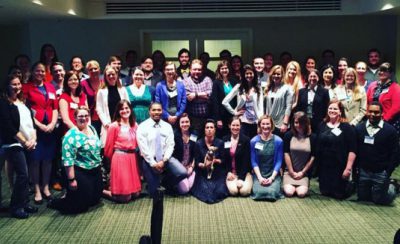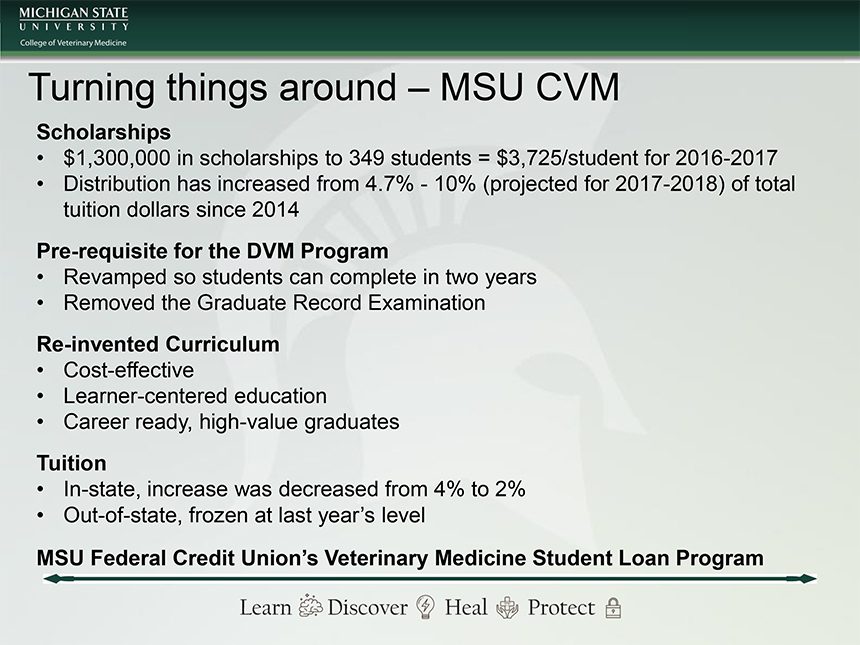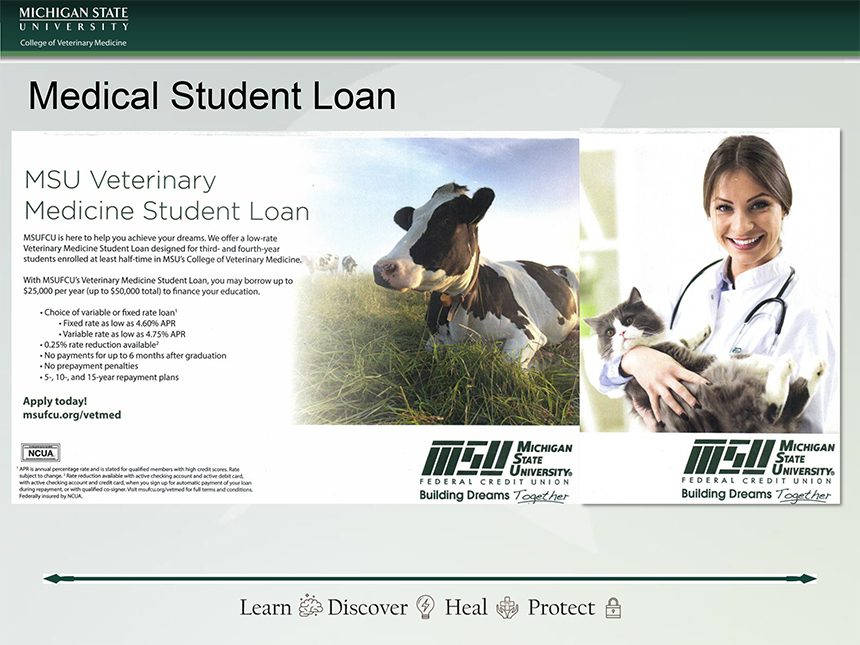Deans of veterinary colleges, industry leaders, associations, and students gather to face the threats posed by educational debt

It’s not every day that 180 people walk out of a meeting with a clear set of actionable items, but that’s what happened Friday, at the end of a three-day summit on veterinary student debt. The working meeting addressed the cost of delivering a veterinary medical education, starting salaries, and the debt’s threat to the veterinary profession and its ability to provide needed veterinary services and knowledge to society.
Next steps generated in the Fix the Debt summit include streamlining curriculum, increasing scholarship opportunities, and petitioning federal lawmakers for lower interest rates on student loans and increased funding of higher education.
Listen to Dr. Mike Chaddock's interview with Brownfield Ag News for America.
The debt-to-income ratio is high in many professions, but is particularly high in veterinary medicine. It currently stands at about 2:1, representing debt at twice the starting income. The average starting salary for veterinarians not entering advanced training is about $65,000. That is just $5,000 more than undergraduates with math degrees, but comes with more than three times the debt.
Shortly after he was named dean of the MSU College of Veterinary Medicine, Dr. John Baker saw the need for large-scale collaboration to address the debt crisis for recent graduates of the College and current veterinary students. The situation requires more than incremental change.
Baker began discussions with the American Veterinary Medical Association (AVMA) and the Association of American Veterinary Medical Colleges (AAVMC) and invited them to partner in hosting a facilitated summit at MSU. The idea was to host a working meeting that would include representatives from four groups of stakeholders associated with the problem. That meeting took place April 20-22 on the MSU campus.
“Seeing Provost Youatt, Senator Stabenow, and so many deans from veterinary schools made us feel like the issue was being taken seriously,” said Felix Rodriguez, MSU Class of 2019. “And being included at the table was very important to us.”
A Life and Death Issue
Dr. Joe Kinnarney, AVMA president, emphasized the need to recognize that educational debt is more than just a financial issue. It is creating not only a tremendous economic burden on our students and recent graduates, but it is also having a negative effect on their professional well-being and mental health.
Wellness resources
The 2014-2015 AVMA Future Leaders focused on wellness issues and developed a Wellness Resources Toolkit for veterinarians.
The toolkit and a professional quality-of-life assessment are available at https://www.avma.org/resources-tools/wellbeing.
“Finances can be a great source of stress for students and veterinarians,” said Kinnarney. “I think our actions at the summit will go a long way toward making a difference and enhancing our efforts to protect, promote, and advance veterinarians and the veterinary profession.”
Matt Holland, president of the Student American Veterinary Medical Association (SAVMA), addressed summit participants Thursday morning. He spoke about debt and wellness, and an issue that is new to many: the clear relationship of student debt to suicide and the fact that veterinarians have one of the highest suicide rates of any profession.
According the CDC, veterinary medicine is one of the four professions with the highest rates of suicide. The others are dentists, physicians, and marine engineers. Veterinarians consider suicide at three times the rate of the US mean and suffer serious psychological distress more than twice as often as the US general population.
SAVMA is urging the AVMA House of Delegates to direct its resources toward helping current and future students deal with the mental health and financial burdens that contribute to the growing depression and suicide rates in the profession.
The AVMA hosted its first wellness roundtable in March and there was an important takeaway: urgent action on educational debt is essential to alleviate serious wellness issues. The AVMA, AAVMC, and MSU organized the Fix the Debt summit for exactly that reason—to understand and take action to address the debt problem.
Stakeholders and Steps to Increasing Salaries
Four groups of stakeholders attended the summit: veterinary students and recent graduates, representatives from veterinary medical colleges, employers of veterinarians, and governmental agencies and veterinary associations. Each group was asked to collaboratively develop solution concepts and define clear steps to reduce the burden on students and new veterinarians.
Several topics and strategies emerged from more than one group. All stakeholders saw the need for graduates that are more broadly ready to enter the workforce. Schools and employers agreed on the benefits of working together to develop curriculum and pre-boarding programs. Students want to see a broader education on financial issues and communications skills. Advanced veterinary, business, and communications skills can all contribute to higher starting salaries.
Employers and colleges agreed there is a need for increased preventative care for animals. More focused training in the curriculum and advanced wellness offerings in practices could increase revenues and salaries.
Representatives of the USDA addressed the importance of communicating the possibilities in non-traditional professions in veterinary medicine, including public health. Advanced degrees also increase salaries for graduates of veterinary programs. These include biomedical sciences, conservation medicine, public health, and pharmacology.
Financial Literacy

There was consensus that students could have more advanced financial literacy. Colleges spoke about the resources available throughout their universities, those offered within their colleges, and the many informational resources online.
To support informed decisions as they apply to schools, students requested that the AAVMC’s Veterinary Medical College Application Service post information in one place about all colleges, including tuition, typical debt load, and starting salaries of graduates. The AVMA agreed to gather and post detailed information about colleges. Students also suggested a mandatory short financial literacy course before applying for veterinary college.
Reducing the Cost
Participants addressed two avenues to reduce the cost of veterinary education: reduce the total cost of tuition of a DVM program and increase scholarships available to students. Colleges are exploring ways to reduce individual student tuition that do not affect the total tuition dollars colleges bring to their universities. The AVMA will be planning a national campaign for scholarships for veterinary students.
Scholarships can reduce the loans necessary for individual students, and the goal is to make funding more widely available. Raising awareness among all stakeholders about the severity of the debt problem will bolster efforts to raise funds specifically for scholarships. Colleges named that a development priority.
Tuition, however, is the primary cause of increased student debt.
“Make no mistake—the single biggest issue here is the decrease in public funding for higher education,” said Dr. John Baker, dean of the MSU College of Veterinary Medicine. “As a profession, we need to address this, and advocate on a state and federal level for increased funding for higher education.”
A Defining Moment

For AAVMC Executive Director Andrew Maccabe, finding viable solutions to the cost of veterinary medical education and issues related to student debt are among the highest priorities for the profession. Fixing the situation will require a determined, sustained effort, possibly some risk-taking and, without a doubt, ongoing collaboration.
“This summit could be a defining moment for veterinary medicine in the United States,” said Maccabe. “The level of determination and commitment to action displayed by each of the participants makes me very confident that we could be on the verge of implementing significant changes in the profession. We are making progress and are talking with one another, not at each other.”
More than 50 participants represented 30 of the 36 accredited veterinary colleges in the United States, Canada, and the West Indies. About 50 veterinary students and recent graduates represented 16 veterinary colleges and more than 10 employers. Associations and organizations that support the profession were represented by 37 participants, including the USDA, FDA, American Animal Hospital Association, National Board of Veterinary Medical Examiners, and state veterinary medical associations.
Read the joint AVMA/AAVMC/MSU press release.


